
Ask a QuestionHere are the questions asked by community members. Read on to see the answers provided by the ThriftyFun community or ask a new question.
So this is a late 17th century Baroque Italian trestle table maybe "STYLE" table. Below are some pictures taken from under the top. I do not think it is 17th century looking at the wood work and the way the rail is attached to the underside of the table!
Can any one confirm this?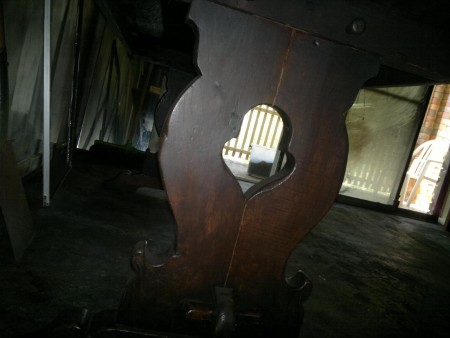


My thoughts are the table is made between 1800s to early 1900s. I saw a similar pattern cutout in the side of a small 3 leg half table which rested against the wall. Your table has a heavy wood beam the table top sits upon and the underside appears to be uneven possibly hand hewn with a plane tool. The cutout boards are two joined together and the pattern was traced onto two separate boards and cut out creating matched pieces of a bell like appearance. Many people of that time period made their own furniture as wood was easily available, often free or cheap and this trestle table is structurally sound; yet simplistic in style.
I would like information about this table. What the part on the bottom was used for or is it just ornamental. What type feet it has and just what kind of table it is. Thanks
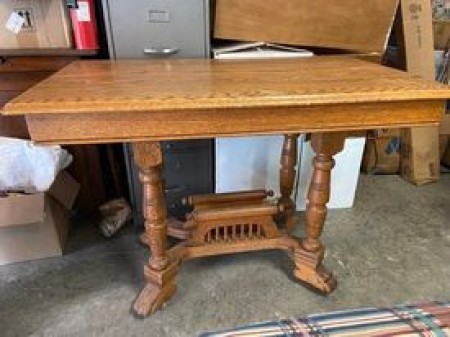
I think this is a Pedestal Table. Pedestal Tables can also have four legs - Double Pedestal Table www.etsy.com/
I could not find the same table as yours, but I found a bit similar, but expending table: FRENCH EXTENDING PEDESTAL DINING TABLE - 11FT 19TH CENTURY ARCHETECTURAL PEDESTAL BASE EXTENDING TABLE Design of French (probably Parisian), sold for £ 5700 www.elisabethjamesantiques.co.uk/
Can someone tell me what this table is and when it was made. What I am concerned about is the under table rail supports. I can not imagine they would make an antique table that way other than in the 20th century.
I know it's at least 30 years old? The pictures are not great; sorry about that.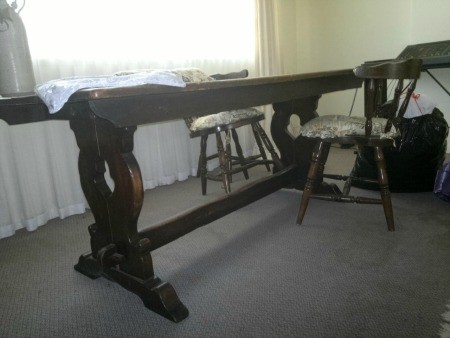
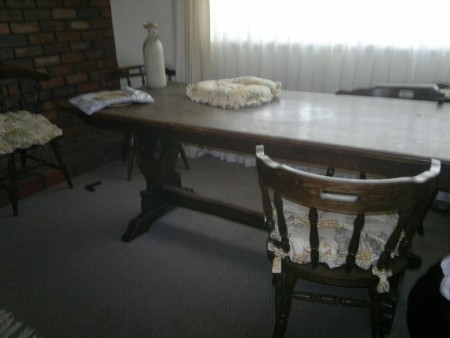
This is a Late 17th Century Baroque Italian Trestle Table STYLE (not sure if it is ACTUALLY FROM the 17th century--this is the style). This needs a true professional to look at it!!!!
You mention about it being at least 30 years old..is that how long it was in your family? If it is just 30, then it may still have some value as the STYLE...but clearly not the big bucks of an authentic piece.
If it was a true 17th century piece, it would be worth several thousand dollars in an auction setting...if you find the right setting....since asking price is just what it says....asking...you need to have a market where someone was willing to pay that amount.
Since it is hard to tell from a photo, I strongly suggest you have a professional antique dealer or appraiser come and look at this and determine its provenance. They will need to know as much as you know about the piece...so be prepared to make the time with them go smoothly.
There are a ton of reproductions of this style out there from all decades after the 17th century and up to today. Some have value, some don't. Condition is everything also.
Post back what a pro tells you!! I am hoping it is REALLY good news for you!! If not, it is a lovely piece and a dealer will be able to tell you how much folks are paying for it where you are located!
So I have added some more pictures to aid in the identification of when this table was made. It does have very thin screws in it which have been covered over by plugs of wood on the sides of the rails or putty on the curved section under the table.
The dowels look to be lathe made with the dead centre hole at the thinner end. They are very strait in the shaft maybe made by a metal lathe using an offset compound top slide method as well as the hole they go into is perfect looking to be Morse taper 3 angle cut by a tapered reamer in a fast rotating drill.
The wedges have pencil markings on them which is shellacked over? Also the wedges are distressed only in the area which is exposed not the area of contact?
I hope this helps you people to put a date on this item. It has some modern cabinet maker methods to it, but what I do not understand is if you are going to make it look like an old piece then why not go all the way and make it with dowels and use hand cut wood planks. It's too close to the real thing to just be a kitsch item at the local furniture store. It must have been sold as the real thing in a trade shop.
It did come from England about 30 years ago being shipped to Australia and was bought with other "genuine antiques" by the then owner. I bought their house and all of the items in it off them recently because they wanted to stay in England. I think they believed it was real being of the 17 century. It also disassembles like a flat pack design. Why would you do that in the 17 or 18 or 19 century?
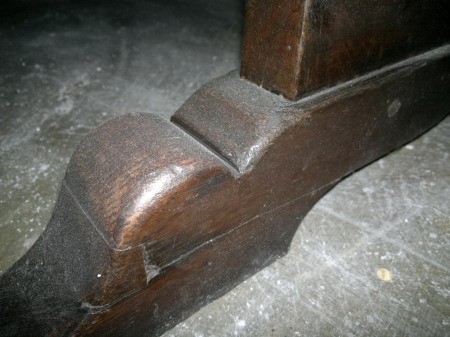
These are very good questions and ones that are so hard to answer if you are not a dealer of antiques or even vintage furniture. In your case it is best to find an antique dealer to go to your home and tell you about all the furniture in this home. They will be the best ones to advise you and let you know what you have.